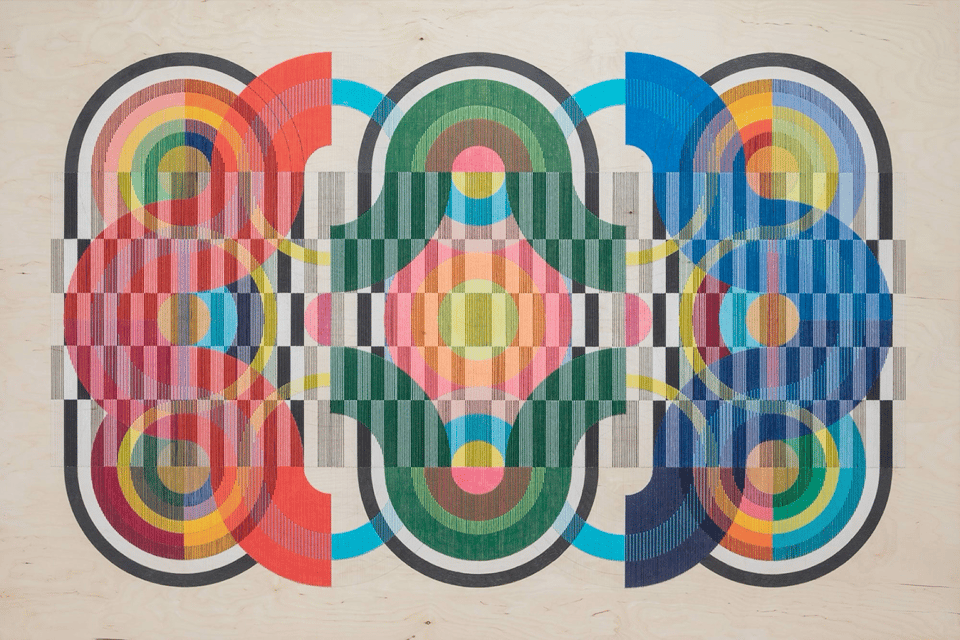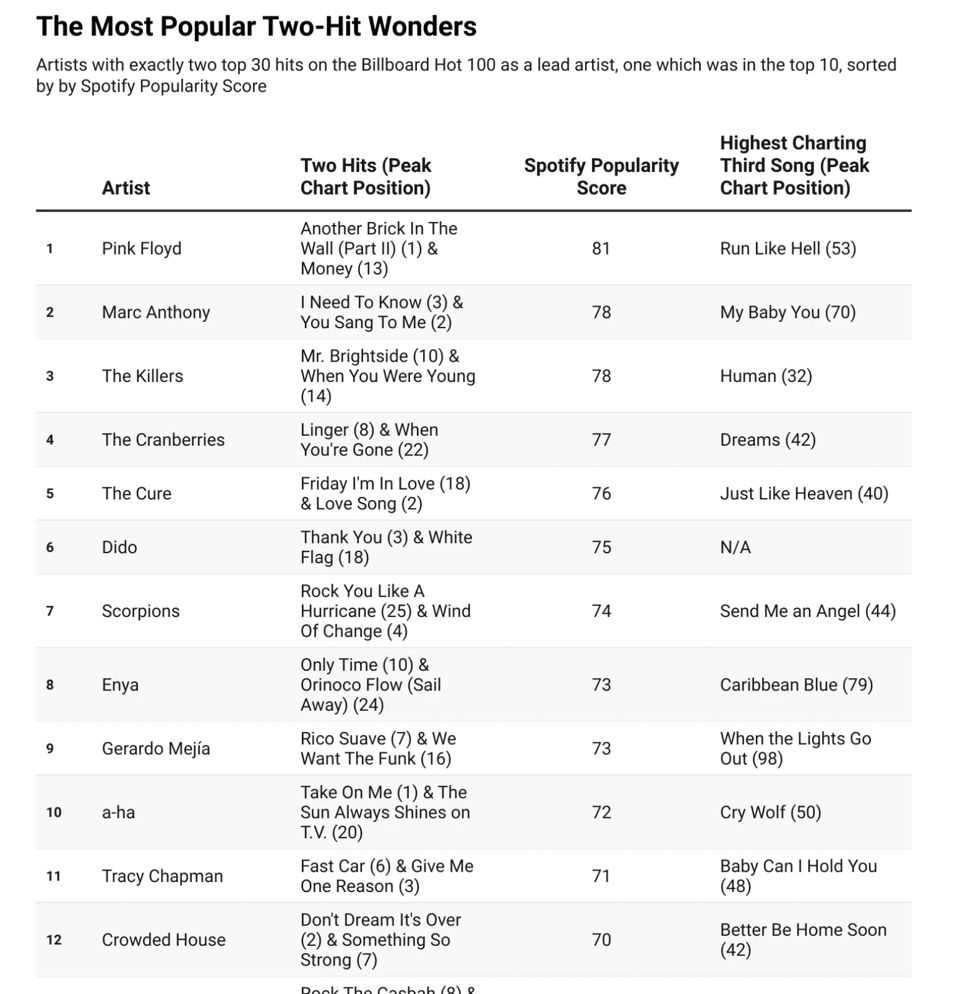Linkfest #33: Two-Hit Wonders, "Moonglass", and Trees That Love Getting Hit By Lightning
Hello folks!
It’s time for "the opposite of doomscrolling” — my next “Linkfest”, in which I do a psychogeographic crawl through the endless sub-basement levels of the Internet, finding the finest bits of culture, science and technology, all for you.
If you’re a subscriber, thank you! If not, you can sign up here — it’s a Guardian-style, pay-whatevs-you-want affair; the folks who kick in help keep the Linkfest free for everyone else.
And hey — share this email with anyone who might enjoy it!
Let’s begin ...
1) 🎨 Tia Keobounpheng’s gorgeous wood-and-thread geometries

Tia Keobounpheng is an artist who has created a series of astonishing textile works by drilling holes in wood panels and weaving colorful threads through them.
The patterns she makes are spellbinding. They possess the precision geometry you find in a lot of textile art — like quilting — but the lines look like some ancient, analog predecessor to computerized vector-drawing.
Keobounpheng’s compositions are both exact and interwoven, as shapes blend into other shapes, neither fully independent nor simply an all-over pattern. She describes the physicality of moving a needle and thread back and forth through paper or wood as a means of metaphorically stitching this worldview into her muscle memory.
The artist’s father is a self-trained architect, and from him, she adopted a modernist lens. “Robert Motherwell, Mark Rothko, and Josef and Anni Albers were early favorites of mine in my teen and young adult years,” she tells Colossal. “These days, Agnes Martin, Hilma af Klint, and Sámi artist Outi Pieski are my anchors of inspiration.”
Go check out her web site to see the scale of some of her other work. It’s all apiece with this geometric exploration, but she uses several other media, including color penciling. Some pieces are huge — wall-sized — and man alive would I ever love to see them F2F! More on her Instagram too.
2) 🎶 Pink Floyd is a “two-hit wonder”

In the world of music, you know about the “one-hit wonder” — a pop act that has one massive hit single, but never another.
But what about the “two hit wonder”? Are there bands that have two massive hit singles, but never have another song hit the charts?
Chris Della Riva wondered, so he did some data scraping. He analyzed the Billboard Top 30 to find bands that had only two hits, and then ranked those bands by their popularity on Spotify.
The result is his list of “The Most Popular Two-Hit Wonders”, above! As he writes …
When you look through this list, you see many interesting acts. Blues Traveler, for example, makes the cut. Though they have a very dedicated fanbase, they technically only have two hits: “Hook” and “Run-Around.” Bonnie Tyler is also a two-hit wonder. “It’s a Heartache” charted at number three in 1977, and “Total Eclipse of the Heart” charted at number one in 1983. [snip]
This list is kind of shocking. Pink Floyd, one of the best-selling bands of all-time, is a two-hit wonder? By the definition, I just outlined, yes. Pink Floyd’s albums always did better than their singles, though. In fact, Pink Floyd might be the platonic form of artists on the list. They are mostly in the rock universe and sell more albums than singles.
This latter point is interesting: A band like Pink Floyd doesn’t feel like a two-hit wonder, because while, sure, okay, it only charted two hit singles, it sold so many damn albums.
So Della Riva did a second analysis — looking for bands that a) had only two Top-30 hit singles, but also b) never had a Top 10 album. The result …

This, as he points out, “feels a bit more two-hit wonder-y.” With the exception of A-ha and Crowded House, these are bands I’m less likely to be familiar with.
Go read the whole post, it’s fascinating!
3) 🕹 Pong running in 240 browser tabs

Nolen Royalty is a programmer and designer famous for creating web art, like One Million Checkboxes.
His most recent, audacious project? A version of Pong that runs in 240 browser tabs!
It works like this: He wrote code that spawns 8 Chrome windows, all lined up slightly offset from one another, and each with 30 tabs open. This creates a grid of 240 tiny tabs, such that only the “favicon” — i.e. the little icon that each web site displays in a Chrome tab — is visible.
Then he tweaked it so the browsers manipulate each favicon such that they function like a single low-rez display. Le voila, Pong!
He wrote a blow-by-blow diary of making the whole game, and it’s riveting to hear him puzzle through the technical challenges.
If you’re not familiar with his previous work, go check out Royalty's site, which lists all his exceptionally cool projects. Better clear aside an hour, though, it’s engrossing stuff.
4) 📬 The secret language of postage-stamp positioning

See that postcard above? In it, a guy named Will writes to Miss L. Leech and says “hope Bob is having some dainty dishes”.
But there’s a hidden message on it, too!
It’s conveyed by the position of the stamp. When the sender put the stamp in the top-right corner — and tilted it off to the left — it carried a secret meaning: I am longing to see you.
(Yikes, I wonder if Bob ever learned about this?)
Apparently this practice — of using stamp-position as a way to send a secret message on a postcard — enjoyed a brief vogue in the late 1800s. As Alex Walker writes …
The system was remarkably subtle and sophisticated. Messages could be as simple as ‘Yes’ or ‘No’ but also as complex as:
“May I ask for your portrait?”
“Take care. We’re being watched.”
“I think you are very ungrateful.”
“My heart is another’s”
“I have discovered your deceit.”
Go check out the article and you can see one of the code-sheets that shows sixteen ways to position a stamp to convey different messages. There was even a full-on codebook …

… which I would love to see a full scan of! Alas, it doesn’t seem to be in the Internet Archive, and the only library I could find with a hard copy is at the University of Cambridge.
(If any of y’all can find a scanned copy online, email me and let me know!)
5) ⚡️ Being struck by lightning can make a tree healthier

We usually assume that if a tree is hit by lightning, it gets turned into a smoking ruin, like the oak tree destroyed in Frankenstein.
It’s the tropical almendro. They grow very tall — up to 55 meters tall — so they attract a lot of lightning strikes. For five years, the scientists tracked lightning strikes on all trees on a Panamanian island, and found that most of the time, lightning hurt the island’s trees. Fully 64% of the trees died.
The exception? Almendro trees. None died after being struck by lightning — and in fact they sustained six times less damage overall than other trees. In fact, almendros received benefits from lightning strikes: The strikes killed off parasitic “liana” vines that were winding around the almendros and choking off their sunlight.
Another benefit of the lightning strikes: smaller trees surrounding the almendros took collateral damage. Within weeks, the shorter trees’ branch tips began to die, presumably because electrical current had sparked across the air, passed through touching leaves, or flowed through shared vines. Over several months, many bystander trees slowly lost leaves and died.
The researchers calculated that living near an almendro increases a given tree’s likelihood of dying during a strike by 48% — so lightning may help eliminate trees that might grow tall enough to compete for an almendro’s sunlight, Gora says. “Any tree that gets close essentially gets electrocuted.”
Nobody yet knows why the almendro is so un-hurt by lightning. But its relative invulnerability creates a feedback effect — because other trees around it die but the almendro doesn’t, it winds up towering above its nearby rivals, thus making it more likely to attract yet another lightning strike.
Man alive, evolution is weird and fascinating! You can read the full academic paper here, unpaywalled.
6) 🦆 How we make “animal sounds” in different languages
![Graphic image showing the word “miau” styled in colorful, blocky phonetic letters ([m][i][a][u]) to represent the sound a cat makes across various languages. On the left, the central graphic reads "[miau]" with the word "TREND" beneath it. On the right, the same cat sound is presented in different scripts and transliterations across 16 languages, including Arabic, Chinese, Czech, English, French, German, Greek, Hindi, Hungarian, Italian, Polish, Portuguese, Russian, Spanish, Thai, and more—each using a version of "[miau]" styled in a matching colorful format.](https://assets.buttondown.email/images/378ec51d-1f12-4e2f-8247-8cd7bb7b6b03.jpg?w=960&fit=max)
If you ask someone to make the sound of a cat meowing, what sound will they make? Would that sound be the same in different countries, with people from different cultures who speak different languages?
Over at The Pudding, Vivian Li got interested in this, and put together a fascinating interactive — looking at how people around the world make a “meow”, “quack”, and “oink” sound. You can click on different pronunciations to hear how it’s done in Arabic vs. Chinese vs. Italian and a bunch more languages.
Turns out different cultures mostly agree on what a cat “meow” sounds like, but not with a pig “oink”. The sounds are so wide-ranging it’s like different cultures each hear pigs in a different way.
Onomatopoeia offers a fascinating glimpse into the interaction between sound and language. The way humans mimic animal sounds reflects not only shared biological instincts but also distinct cultural filters. Although onomatopoeia intends to imitate faithfully, its differences are ultimately far from arbitrary. In trying to capture the same auditory essence, English interprets a pig’s sound as [ojŋk], yet Hungarian hears [røf], and Vietnamese hears [ʔut it]. Even among the three animals discussed, cats are more consistent in their sound interpretation, while pigs are more variable — whether because pigs’ vocalizations are innately more complex, or because they call upon different phonotactic rules.
7) ☀️ Solar-panel camper van drove 2,000 km without plugging in

The “Stella Vita” is an experimental camper-van that’s so pimped-out with solar panels that it recently drove 2,000 km without needing to be plugged in.
When it’s parked, the extendable roof can rise up to allow passengers to stand, and extra solar panels slide out from the sides, doubling the solar surface from 8.8 square meters to 17.5 square meters.
It’s a fun concept! I really dig the idea of fold-out panels that simultaneously provide shade for campers while generating extra juice.
Mind you, the design also shows the limits of powering a car solely from the panels, and without plugging it in to recharge. As the designers explain in this video, the van was only traveling 200 km per day — which equals perhaps two to two-and-a-half hours of driving, per full day of charging in the sun. A pretty leisurely pace for a cross-country trip.
But hey, this is only the alpha version. As batteries get better and lighter (this version possesses a battery pack only the size of your standard Tesla) and panels more productive, the range and capabilities of panel-powered vehicles will only go up.
8) 🤖 Turn any web site into a Geocities page

This is excellent: Paste any URL into Geocities.live …
… and it will take that site’s HTML and re-do it so it looks like it was made using Geocities, the 1990s-era web-site-generation famous for apocalyptically bonkers aesthetics.
Above is the last issue of the Linkfest, Geocities-ified!
Maybe I should redesign my newsletter so it looks like that, all the time? 😂
That Geocities aesthetic is such a fascinating inflection-point in the history of the web. It was the first moment when everyday folks got their hands on HTML and CSS … but before anybody had a sense of what made for “good” UI principles. So they just went hog-wild and made stuff that looked like the side of a 1970s van, ornate and filigreed and twitchily glitching. It reminds me of a similar moment, ten years previous in the late 80s, when WYSIWYG word-processors first emerged — and everyday folks went similarly apeshit producing birthday cards and party invitations that had like seventeen fonts per page and skirted the outer precincts of legibility.
Personally, I love that style! In moderation, lol; but I love it. In today’s world of spare, clean, heavily-whitespaced design, it’s refreshing to see web sites that are intentionally baroque and aggro.
Mind you, that loopy design has never entirely gone away. It may have vanished from mainstream website design, but it resurfaced in meme culture, which has long embraced lo-fi grotesquerie. And hey, Gen Z is apparently in the process of rediscovering Tumblr? Who says kids don’t read the classics!
9) 🖊 Writing apps by drawing them with a pen

I’m fascinated by “Inkbase” — an experimental software environment that lets you draw a UI interface with a pen, which comes to life so you can use it as an app.
Above is an example: The user wants to track whether they’re doing their daily workouts, so they draw a line of boxes for each day of the week.
When they check a box, it turns red. If they check several days in a row it draws a line underneath those days to show a “streak” — and moves the line if, later on, the streak is broken.
Inkbase is just a prototype, not a product you can (yet) buy. Its creators work for Ink and Switch, a fascinating research lab that creates new digital “tools for thought”. They’ve written up a cool essay about this whole idea of “programmable ink” …
Despite an overabundance of other tools, many people still turn first to pen and paper for ideating, note taking, sketching, and more.
There is something special that happens in the brain when making marks by hand, and a large body of research suggests it has various advantages, whether for learning and psychological development, retention of material, or activating more pathways in the brain.
What the hand does, the mind remembers.
~ Maria Montessori
For decades, I’ve been obsessed with studying the cognitive style of different forms of note-taking and sense-making. One of my frustrations, during the rise of social media, was that gazillions of tech entrepreneurs were (and still are) focused on making tools for communicating with other people.
That’s a valuable task, of course! But we also need more tools for communicating with ourselves: For capturing ideas and information, musing on it, mulling it over, and formatting it in new ways to create fresh epiphanies. That essay is a really chewy, intelligent romp through the cognitive implications of a pen-based smart-ink process.
Go check out the entire Ink and Switch site; they have a ton of other provocative prototypes. I will probably put their newfangled spreadsheet in an upcoming Linkfest …
10) 🇨🇦 The linguistic function of the Canadian “eh”

As a Canadian, I can confirm: We really do say “eh" a lot at the end of our sentences.
It feels natural to do so, but it’s never been totally clear to me why it feels natural.
Over at Atlas Obscura, Dan Nosowitz talks to some linguists who’ve analyzed “eh”. They say this particular “tag” — i.e. a suffix to a sentence — is so common because it serves as a social glue within a conversation:
There are a few major ways a Canadian could use “eh.” The first is while stating an opinion: “It’s a nice day, eh?” Another would be as an exclamation tag, which is added to a sentence in order to indicate surprise: “What a game, eh?” Or you could use it for a request or command: “Put it over here, eh?” And then there’s the odd example of using it within a criticism: “You really messed that one up, eh?”
Jack Chambers, a linguist at the University of Toronto, writes that these “ehs” are all of a piece. “All of these uses have one pragmatic purpose in common: they all show politeness,” he wrote in a 2014 paper. Using “eh” to end the statement of an opinion or an explanation is a way for the speaker to express solidarity with the listener. It’s not exactly asking for reassurance or confirmation, but it’s not far off: the speaker is basically saying, hey, we’re on the same page here, we agree on this.
Even in the use of “eh” as a criticism or a command, the word seeks to find common ground. If I say “you’re an idiot, eh?”, what I’m saying is, you’re an idiot, but you should also think you’re an idiot, and our understanding of you as an idiot finds us on common ground.
Another great one is when someone is telling a story and puts an “eh” at the end of every sentence …
This is the variety you’ll hear in skits like SCTV’s Bob and Doug McKenzie: it’s found during stories, following individual clauses. “So I was walking down the street, eh? And I saw a friend of mine at the store, eh? And so I thought I’d say hi, eh?”
(That’s not self-parody, BTW; when I hang out with relatives in southern Ontario, the locale with an exceptionally dense regional deployment of “eh”, this how it goes 😅)
Chambers says the narrative “eh” is used to indicate to listeners that the story is continuing, to make sure the listener is still listening, and to signal that the listener should not interrupt because there’s more to come.
Fascinating stuff, eh?
11) 💭 Steam as a service

You know how gritty movies set in NYC will have a night-time shot with steam pouring out of a manhole cover?
Do you ever wonder, wait, wait: Where is that steam coming from?
I never knew this, and hell, I live in New York city! I’ll be cycling around downtown and pass by a huge column of steam. I figured it was … I dunno, dragons? C.H.U.D.s?
It turns out New York has companies that sell steam as a service, piping it to buildings for heat, or for commercial purposes, like dry cleaners or sterilizing medical equipment. There’s a massive network of pipes under the city that was built in the 1880s when the New York Steam Corporation began offering steam to residential and commercial buildings.
Jamie Rumbelow has written a fantastic history of the steam networks, crammed full of intriguing details …
Today … ConEd’s largest facility sits along the East River, taking up the lion’s share of a city block on 14th Street. At this plant, a dozen massive boilers heat water to approximately 177 degrees celsius and push it into the network at 150 pounds per square inch (roughly equivalent to ten atmospheres).
The scale of all this is considerable. The six boiler sites together have a total capacity of roughly 11 and a half million pounds of steam per hour; at peak times they use over nine million. Every gallon of water produces just over eight pounds of steam, which means that the system consumes nearly two Olympic swimming pools’ worth of water per hour during the winter.
Delivering steam has some weird dangers, including the dreaded “waterhammer’ …
[The] most dramatic failure is called a waterhammer. Sometimes the condensate can form a ‘slug’ of water that fills the entire cross-section of the pipe. When a slug comes into contact with the high-pressure steam, it gets pushed through the piping and accelerated to ridiculous velocities, often reaching over 100 miles per hour (50 meters per second).
When this fast-moving water reaches a closed valve, sharp bend, or other obstruction in the pipe, it crashes into whatever it has found, producing a spike of pressure much higher than the standard operating pressure of the system. This can cause significant damage and in some cases total system failures.
The last total system failure was in 2007, when an 82-year-old pipe at 41st and Lexington exploded, showering Midtown in debris. Heavy rainfall had cooled the pipes, producing large amounts of condensate quickly, and a clogged steam trap meant that the system was unable to expel the water. When this build-up hit a critical level, the internal pressure shot up, causing the explosion. Almost fifty people were injured, and one woman died of a heart attack while fleeing.
In 1932 the New York Steam Corporation published a gorgeous book commemorating “Fifty Years of New York Steam Service”, and the illustrations are spectacular — the Internet Archive has a full scan, go check it out!
12) 💊 AI model finds new, lifesaving uses for existing drugs

Here’s a very cool story: David Fajgenbaum, a doctor at the University of Pennsylvania, has developed an AI model that suggests new and unusual ways to administer existing drugs (gift link).
In Birmingham, Ala., an A.I. model suggested a 19-year-old patient debilitated by chronic vomiting try isopropyl alcohol, inhaled through the nose. “Essentially we ran a query that said, ‘Show us every proposed treatment there has ever been in the history of medicine for nausea,’” said Matt Might, a professor at University of Alabama at Birmingham who leads the institute that developed the model.
The alcohol “popped to the top of our list,” Dr. Might said, and “it worked instantly.” [snip]
The model developed by Dr. Might’s institute has successfully predicted other treatments, too: Amphetamines typically used to treat A.D.H.D. relieved periodic paralysis in children with a rare genetic disorder. A Parkinson’s drug helped patients with a neurological condition move and speak. A common blood pressure medicine called guanfacine drastically improved the mobility of a pediatric patient with a different neurological condition.
Basically, the model works by analyzing drugs for their side effects.
All drugs have side effects, of course, and those side effects are usually regarded as negative. But sometimes they’re useful — so you can “repurpose” the drug specifically to harness it. Viagra was originally developed as a cardiac drug, and its ability to cause erections was a side effect; semaglutides were developed as a diabetes drug, but their side effect of weight loss has now become their main effect.
So basically, Fajgenbaum takes someone who’s sick, pumps their symptoms into his AI model, and it tries to find a drug where the side effects could help out.
The advantage here? Repurposing existing drugs is fast. They already exist; hell, often they’re generic and cheap. In contrast, trying to cure a disease by developing a new drug takes years and huge R&D money. So Fajgenbaum is unlocking tons of useful cures that are, in effect, already ripe for the picking.
The one thing I’d like to know — but which isn’t in that piece — is what type of AI model Fajgenbaum uses. There are a lot of possible pattern-matching styles that might be at work here …
13) ⚾️ The “torpedo” bat changes the game

The New York Yankees have adopted a new bat — and it is dramatically boosting their home-run rates.
Consider their recent game against the Milwaukee Brewers, in which the Yankees nailed nine home runs. The team is hitting well over three times as many homers as its nearest competition. Last year, Major League teams hit only 1.12 homers a game on average; the Yankees have hit 15 home runs in only three games.
What changed? They started using a “torpedo” bat.
As James Dator at SB Nation describes it …
Rather than having an even taper from tip to grip, the Torpedo has a pronounced bulge in the barrel designed to redistribute the center of mass in the bat from the end, moving it down and where players most often make contact.
The bat was invented by a former Yankees’ staffer, Aaron Leanhardt, who got an MIT PhD in physics and spent seven years as a physics prof before becoming a hitting coach for the Yankees.
I immediately wondered, wait, wait, how the hell is it kosher for a team to invent its own new high-tech bat?
There’s nothing about the new bats which is fundamentally against MLB rules. Section 3.02 outlining the rules of a bat leads with a basic description of what it takes for a bat to be allowed.
(a) The bat shall be a smooth, round stick not more than 2.61 inches in diameter at the thickest part and not more than 42 inches in length. The bat shall be one piece of solid wood.
Nothing about the Torpedo is in breach of this. MLB rules state that the thickest part of the bat can’t exceed 2.61 inches in diameter, but crucially don’t say where the thickest part of the bat needs to be. All Leanhardt and the Yankees did was choose to have the thickest part of their bat further down the barrel, rather than a uniformed tapered stick.
In addition, the Torpedo was approved by Major League Baseball prior to the season, meaning that it does not fall under the clause of “experimental bats,” as outlined in the rule book. While it anecdotally looks much larger than comparison bats, the reality is that a majority of MLB players have never used a bat that maxes out the 2.61 inch diameter, as the Topedo does.
Damn. I don’t really follow sports at all, but I do follow physics and materials science and engineering — so I love stories about how innovations in those fields can produce remarkable new tools for athletic performance. Man, I could lose days reading about golf-ball-dimple design and high-end tennis-racket graphite engineering.
14) 🚢 A final, sudden-death round of reading material
The “Momo army”. 🚢 The Dog Aging Project. 🚢 Wheelchair that rolls using a single spherical wheel. 🚢 Planting trees via drone. 🚢 Corpse flowers suffer from inbreeding. 🚢 The world’s most complicated watch. 🚢 “Moonglass” solar panels made from lunar regolith. 🚢 The return of “slugging”. 🚢 A gram of silica gel has the surface area of two basketball courts. 🚢 Blending solitaire with cellular automata. 🚢 Gorton, the hardest-working font in Manhattan. 🚢 Estimating the number of undiscovered Modiglianis. 🚢 Piano doorbell. 🚢 A nine-year-long Kickstarter to reinvent the spoon. 🚢 India moved out of extreme poverty without industrialization, but how? 🚢 The de-spicing of NYC’s food. 🚢 The price of quantum randomness is dropping. 🚢 The Chordinomicon. 🚢 Voice-controlled drones. 🚢 Cate Blanchett vs. leaf blowers. 🚢 Synthesizer museums. 🚢 The earth’s mantle “may store several oceans’ worth of water”. 🚢 AI Labyrinth. 🚢 Which animal poops the most per kg of body mass? 🚢 Scroll buddy. 🚢 On the experience of going viral for making WikiTok. 🚢 Puzzle-solving coyotes. 🚢 Emily Dickinson’s letterlocking. 🚢 Ten of the tallest abandoned skyscrapers in the world. 🚢 It turns out Dudeney’s Dissection is optimal. 🚢 History of the “manicule”. 🚢 Discovery of a Hittite tablet that seems to presage the language of The Iliad. 🚢 While running a marathon, the brain can start to eat itself. 🚢 If Electronic Arts remade Super Mario. 🚢 Study finds people can predict someone’s name by looking at their face. 🚢 A brief history of teenage dance halls. 🚢 Rotating OHIO. 🚢 2007 Coke commercial with music by Jack White. 🚢 Tetra Puzzle. 🚢 The Instagram filter of the 19th century. 🚢 He found a 1,900-year-old coin after six years of hunting in one single field. 🚢 A cozy game about cleaning up oil spills. 🚢 Turning Reddit posts into movies. 🚢 Vibe Designing. 🚢 A very weird Martian rock. 🚢 The cybernetic CEO. 🚢 The great Capacitor Plague of 2002. 🚢 “The Ants”, a short and soul-skewering poem. 🚢 Browsercraft. 🚢 Using an LLM to craft synthesizer sounds. 🚢 A new class of antibiotics just dropped. 🚢 The making of a “typing horror” game. 🚢 Sunflower parthenogenesis.
CODA ON SOURCING: I read a ton of blogs and sites every week to find this material. A few I relied on this week include Strange Company, Hackaday, Messy Nessy, Andrew Drucker’s Interesting Links, Numlock News, the Awesomer, the Morning News, and “When The Going Gets Weird”; check ‘em out!